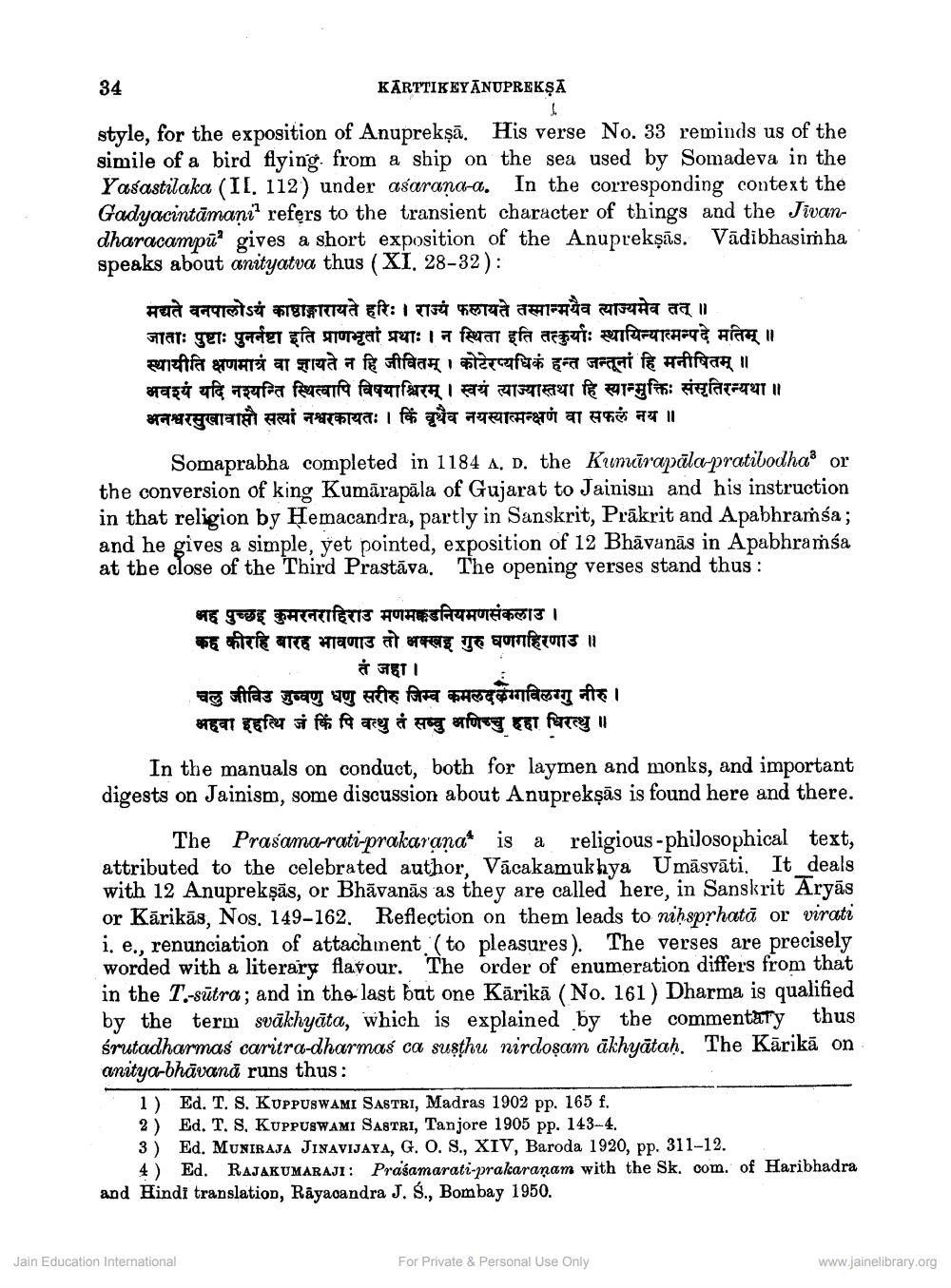________________
34
KĀRTTIKEYANUPREKŞA
style, for the exposition of Anuprekşā. His verse No. 33 reminds us of the simile of a bird flying from a ship on the sea used by Somadeva in the Yasastilaka (II. 112) under asarana-a. In the corresponding context the Gadyacintāmani? refers to the transient character of things and the Jivandharacampū gives a short exposition of the Anuprekşās. Vādibhasimha speaks about anityatva thus (XI. 28-32):
मद्यते वनपालोऽयं काष्ठानारायते हरिः। राज्य फलायते तस्मान्मयैव त्याज्यमेव तत् ॥ जाताः पुष्टाः पुनर्नष्टा इति प्राणभृतां प्रथाः। न स्थिता इति तत्कुर्याः स्थायिन्यात्मन्पदे मतिम् ॥ स्थायीति क्षणमात्रं वा ज्ञायते न हि जीवितम् । कोटेरप्यधिकं हन्त जन्तूनां हि मनीषितम् ॥ अवश्यं यदि नश्यन्ति स्थित्वापि विषयाश्चिरम् । स्वयं त्याज्यास्तथा हि स्यान्मुक्तिः संसृतिरन्यथा ॥ अनश्वरसुखावाप्तौ सत्यां नश्वरकायतः । किं वृथैव नयस्यात्मन्क्षणं वा सफल नय ॥
Somaprabha completed in 1184 A, D. the Kumarapāla pratibodha: or the conversion of king Kumārapāla of Gujarat to Jainism and his instruction in that religion by Hemacandra, partly in Sanskrit, Prākrit and Apabhraṁśa; and he gives a simple, yet pointed, exposition of 12 Bhāvanās in Apabhraíba at the close of the Third Prastāva. The opening verses stand thus :
मह पुच्छइ कुमरनराहिराउ मणमकडनियमणसंकलाउ । कह कीरहि बारह भावणाउ तो अक्खइ गुरु घणगहिरणाउ ॥
. TETI चलु जीविउ जुम्वणु धणु सरीरु जिम्व कमलदग्गविलग्गु नीरु ।
अहवा इहत्थि जं किं पि वत्थु तं सम्वु अणिच्चु हहा धिरत्थु ॥ In the manuals on conduct, both for laymen and monks, and important digests on Jainism, some discussion about Anuprekşās is found here and there.
The Prasamarati-prakarana* is a religious-philosophical text, attributed to the celebrated author, Vācakamukhya Umāsvāti. It deals with 12 Anuprekşās, or Bhāvanās as they are called here, in Sanskrit Aryās or Kārikās, Nos. 149-162. Reflection on them leads to nihsprhatā or virati i, e., renunciation of attachment (to pleasures). The verses are precisely worded with a literary flavour. The order of enumeration differs from that in the T.-sūtra; and in the last but one Kārikā (No. 161 ) Dharma is qualified by the term svākhyāta, which is explained by the commentary thus śrutadharmas caritra-dharmas ca susthu nirdosam ākhyātah. The Kārikā on anitya-bhāvanā runs thus:
1) Ed. T. S. KUPPUSWAMI SASTRI, Madras 1902 pp. 165 f. 2) Ed. T. S. KUPPUSWAMI SASTRI, Tanjore 1905 pp. 143-4. 3) Ed. MUNIRAJA JINAVIJAYA, G. O. S., XIV, Baroda 1920, pp. 311-12.
4) Ed. RAJAKUMARAJI: Prasamarati-prakaranam with the Sk. com. of Haribhadra and Hindi translation, Rayasandra J. S., Bombay 1950.
Jain Education International
For Private & Personal Use Only
www.jainelibrary.org




